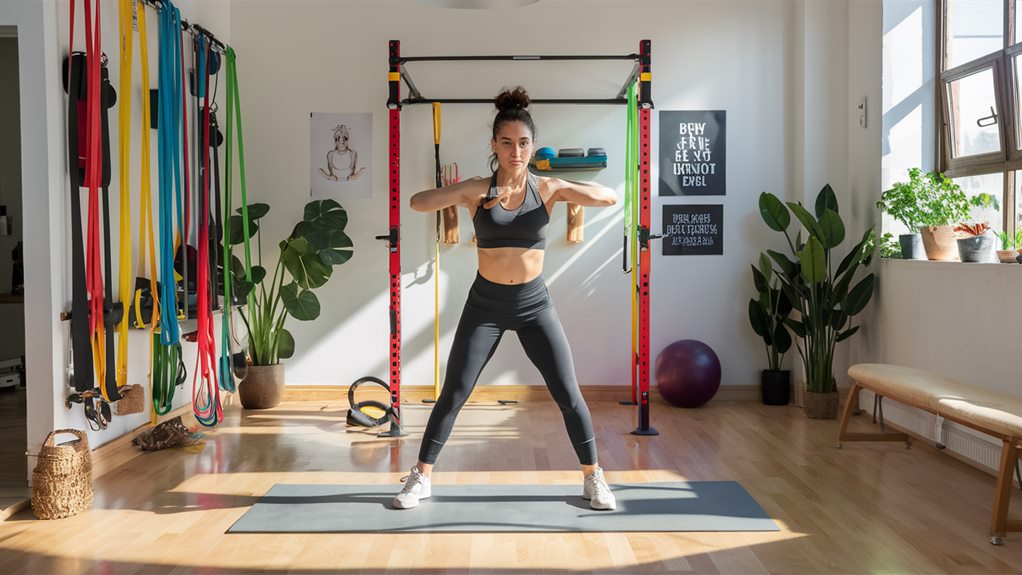Resistance band workouts are perfect for beginners like you who want to get fit without heavy equipment. Start with basic exercises such as bicep curls, squats, and seated rows to build strength and tone your muscles. Use loop bands for lower body workouts and tube bands with handles for upper body exercises. Aim for 3 sets of 10-15 reps for each exercise, adjusting the resistance as you progress. Remember to focus on form to prevent injuries and track your progress for motivation. There's plenty more to explore that can enhance your workout experience and boost your results.
Key Takeaways
- Start with basic exercises like bicep curls, squats, and chest presses to build foundational strength.
- Choose resistance bands based on your fitness level, considering color for resistance levels.
- Incorporate a full-body routine using various band types to target all muscle groups effectively.
- Focus on proper form and control during workouts to optimize results and prevent injuries.
- Warm-up before starting and track your progress to stay motivated and adjust your routine as needed.
Benefits of Resistance Band Training
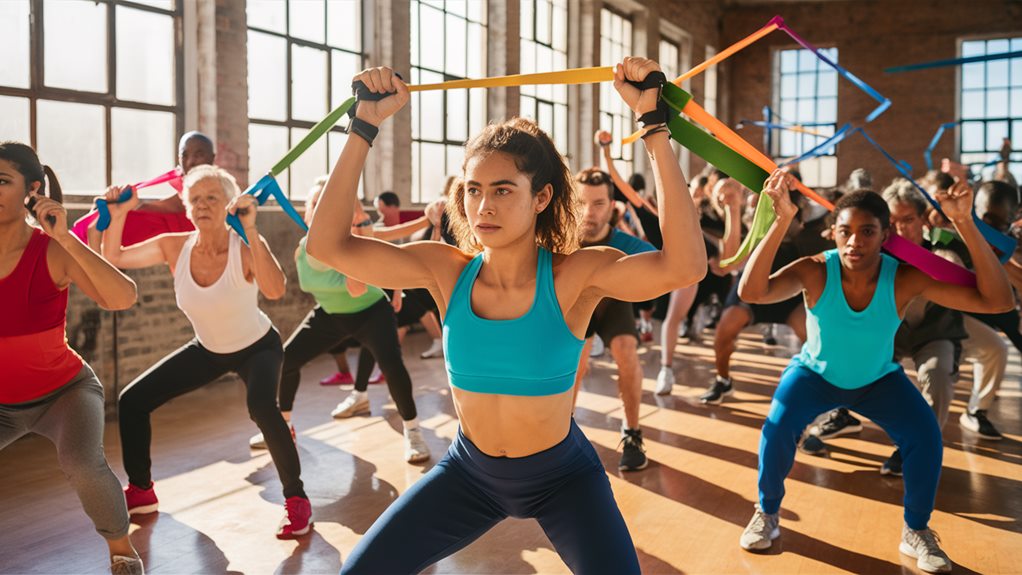
When it comes to starting a workout routine, resistance band training offers numerous benefits that can enhance your fitness journey. One of the standout advantages is muscle toning. With resistance bands, you can target specific muscle groups effectively, helping you achieve that sculpted look you're aiming for. By incorporating different exercises, you'll challenge your muscles in various ways, promoting strength and definition.
In addition, bands provide versatile resistance levels that allow you to easily adjust the intensity to match your fitness level.
Another significant benefit is improved flexibility. Resistance band training encourages a greater range of motion in your joints, which is essential for overall mobility. As you perform stretches and resistance exercises, you'll notice increased elasticity in your muscles and tendons. This not only enhances your performance during workouts but also reduces the risk of injuries in daily activities.
Furthermore, resistance bands are incredibly versatile and can be used for a wide range of exercises, from upper body to lower body workouts. You can seamlessly incorporate them into your routine, whether you're at home, in the gym, or even while traveling.
Essential Resistance Band Types
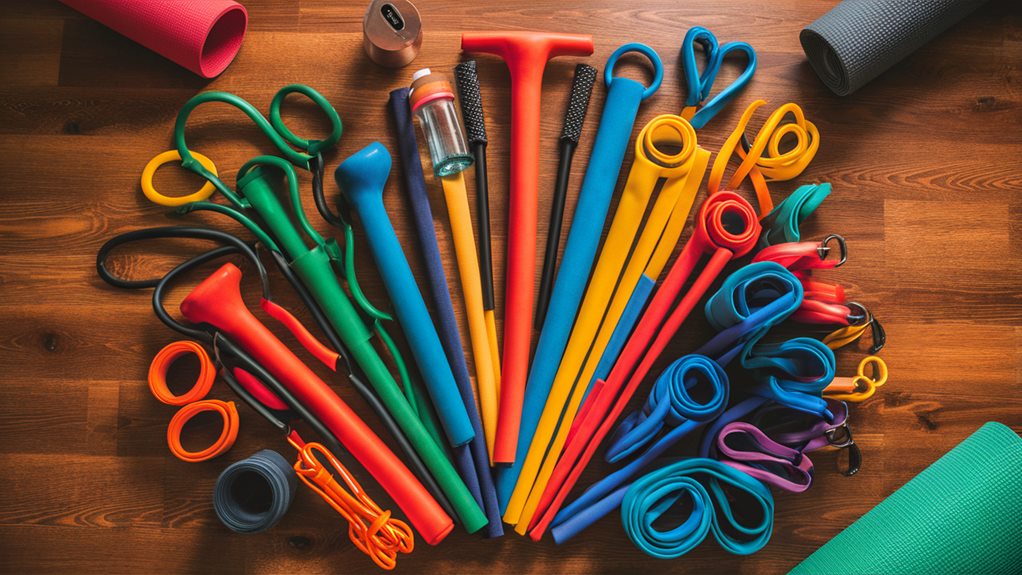
There are several essential types of resistance bands that can elevate your workout experience. Understanding the different resistance band varieties available will help you choose the right one for your fitness goals. The most common types include loop bands, tube bands with handles, and therapy bands. Each type offers unique benefits and can be used effectively for various exercises. For instance, the best ab roller wheels can complement your resistance band routine by targeting core strength.
Loop bands are versatile and great for lower body workouts, allowing you to target your legs and glutes.
Tube bands with handles are fantastic for upper body exercises, offering a good grip and the ability to work on strength and toning.
Therapy bands, typically flat and without handles, are perfect for rehabilitation exercises and gentle stretching.
When it comes to resistance band tension levels, they usually range from light to heavy. Light bands are excellent for beginners or those focusing on flexibility and endurance, while heavier bands provide more resistance for strength training. As you progress, you'll want to explore different tension levels to challenge yourself and prevent plateaus.
How to Choose the Right Band
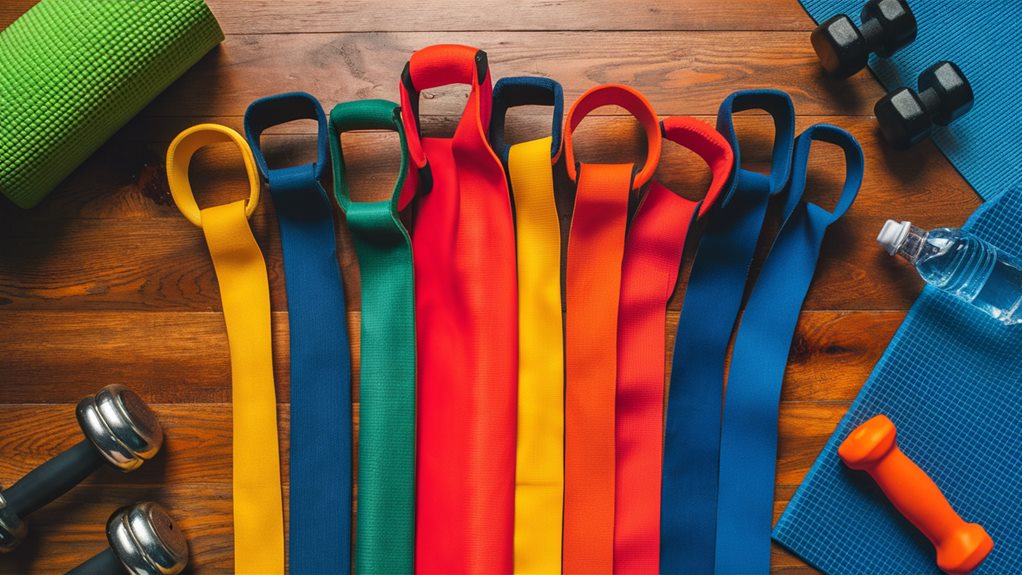
Choosing the right resistance band can make all the difference in your workout routine. With so many options available, finding a band that suits your fitness level and goals is crucial. Here are three key factors to keep in mind when selecting your band:
- Band Color: Resistance bands come in various colors, and each color typically corresponds to a specific resistance level. For instance, lighter colors may indicate lower resistance, while darker colors suggest higher resistance. Make sure to check the manufacturer's guide to understand the significance of each color. Moreover, many sets offer bands with a variety of colors to cater to different resistance levels, providing diverse workout options customized to your needs.
- Resistance Levels: Everyone's strength levels vary, so selecting a band that aligns with your current fitness level is vital. If you're a beginner, opting for a band with lighter resistance can help in gradually building your strength. As you advance, transitioning to bands with increased resistance levels can offer more challenging workouts. Keep in mind that some sets provide a total resistance of up to 150 lbs, making them perfect for progressive training.
- Band Length and Material: Take into account the length and material of the band, as these aspects impact your comfort and the range of exercises you can perform. Seek out a band that's sufficiently long to accommodate various movements, and opt for a material that's both durable and comfortable on your skin. Premium bands crafted from natural latex or TPE offer exceptional elasticity and durability, ensuring they can endure regular use.
Basic Resistance Band Exercises
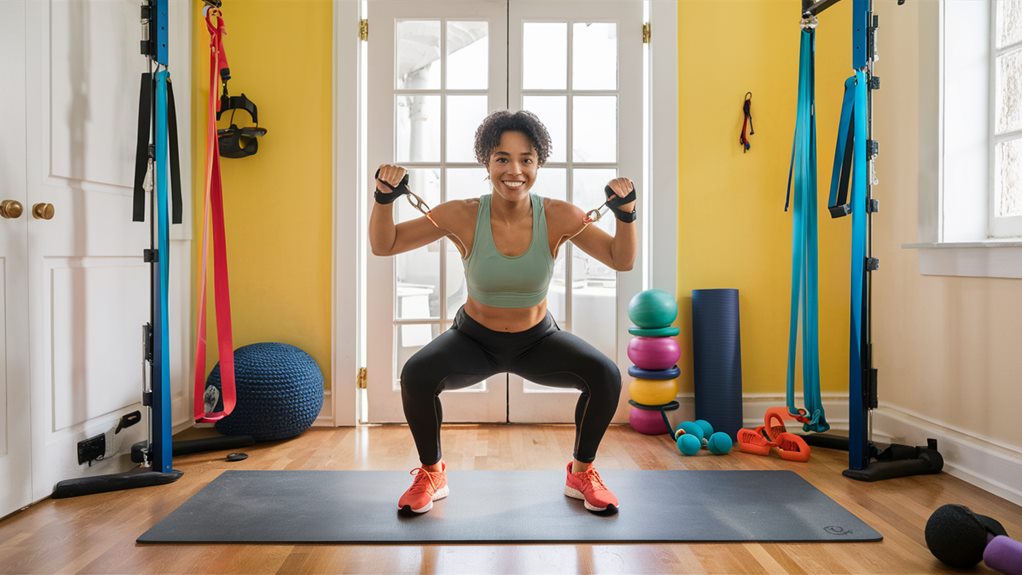
Now that you've selected the right resistance band, it's time to put it to work with some basic exercises. These foundational movements will help you build strength and confidence as you start your fitness journey. Let's immerse ourselves in a few effective resistance band techniques that cater to beginners, with modifications to suit your level.
Here's a quick overview of some basic exercises you can try:
| Exercise | Description | Beginner Modifications |
|---|---|---|
| Bicep Curls | Stand on the band, grasp handles, and curl up. | Use a lighter band or perform seated. |
| Seated Row | Sit with legs extended, band around feet, pull back. | Shorten the band for less resistance. |
| Squats | Stand on the band, hold handles at shoulders, squat. | Perform without the band for support. |
| Chest Press | Anchor band behind, hold handles, push forward. | Use a lighter band or press from a seated position. |
Full-Body Workout Routine

As you immerse yourself in your fitness journey, incorporating a full-body workout routine with resistance bands can be a game-changer. This type of routine isn't only effective in building strength but also adaptable to your fitness level, making use of versatile options to suit your needs.
Here's a simple yet powerful full-body workout you can try, with options for resistance band modifications and progression tips.
- Squats: Stand on the band with feet shoulder-width apart. Hold the handles at shoulder level and squat down, keeping your chest up. To progress, increase the resistance by using a thicker band or adding more repetitions.
- Chest Press: Anchor the band behind you and hold the handles at chest height. Push forward until your arms are fully extended. For a modification, step closer to the anchor point to lessen resistance. As you get stronger, try using a band with more resistance or increase the number of sets.
- Bent-Over Row: Stand on the band and bend slightly at the waist, holding the handles. Pull the band toward your chest while squeezing your shoulder blades together. For a progression, try slowing down the movement to increase muscle tension.
Upper Body Resistance Band Workout

Upper body workouts with resistance bands can greatly enhance your strength and stability while being easy to incorporate into your routine. These bands are versatile and perfect for shoulder sculpting and arm toning, making them an excellent choice for beginners.
Start with a simple shoulder press. Anchor the band under your feet, hold the ends at shoulder height, and press upward until your arms are fully extended. This move not only builds shoulder strength but also engages your core for added stability. Aim for 3 sets of 10-15 reps.
Next, try bicep curls. Stand on the band, grasp the ends, and curl your hands toward your shoulders. This exercise is fantastic for arm toning, giving your biceps a solid workout. Again, aim for 3 sets of 10-15 reps.
For tricep extensions, stand on the band and hold it behind your back. Extend your arms upward and feel the burn in your triceps. This exercise is essential for balancing your upper body strength. Complete 3 sets of 10-15 reps here too.
Finally, incorporate lateral raises. Stand on the band and lift your arms out to the side until they're parallel to the floor. This move helps with shoulder sculpting, ensuring you achieve that well-defined look.
With these exercises, you'll build strength and confidence while feeling connected to your fitness journey. Remember, consistency is key, so keep at it, and celebrate your progress!
Lower Body Resistance Band Workout
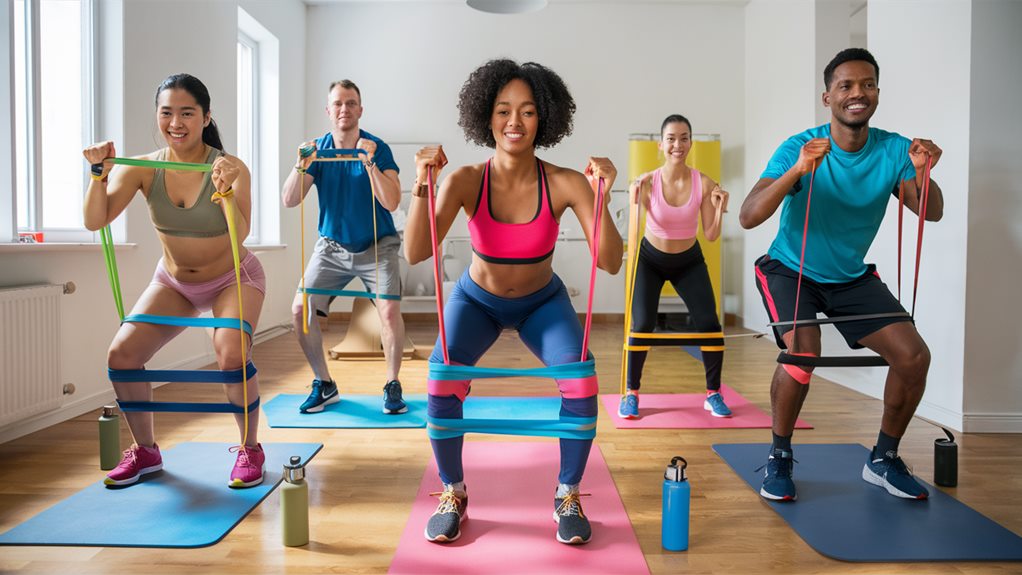
Building on your upper body strength, it's time to focus on your lower body with resistance bands. These versatile tools can help you achieve effective glute activation and leg strengthening, making your workouts both challenging and rewarding. Here are three great exercises you can incorporate into your routine:
- Squats with Resistance Band: Place the band just above your knees and stand with your feet shoulder-width apart. Lower into a squat, ensuring your knees don't cave in. This exercise targets your glutes and quads effectively.
- Lateral Band Walks: With the band still above your knees, take a step to the side, maintaining tension in the band. This move not only strengthens your legs but also activates your glutes. Aim for 10-15 steps in each direction.
- Glute Bridges: Lie on your back with the band around your thighs, just above your knees. Push through your heels to lift your hips, squeezing your glutes at the top. Lower back down and repeat. This exercise is fantastic for glute activation and building strength in your posterior chain.
Integrating these exercises into your workout routine won't only enhance your lower body strength but also help you feel more connected to your body's capabilities. Embrace the challenge, and you'll be well on your way to a stronger, more toned lower body!
Core Strengthening With Bands

Feeling the need to strengthen your core? You're not alone! A strong core is essential for overall fitness, providing the stability you need for everyday activities and workouts. Resistance bands are a fantastic tool to enhance your core strength while offering unique stability challenges that traditional exercises mightn't provide.
Start with the band around your thighs for a seated band twist. Sit on the floor, lean back slightly, and twist your torso side to side. This not only targets your obliques but also engages your entire core, promoting flexibility improvements as you stretch and rotate.
Next, try the banded plank. Loop the band around your wrists and get into a plank position. As you hold, press outward against the band. This will create stability challenges that force your core to engage even more, resulting in a deeper workout.
For a fun twist, incorporate the band into a standing side bend. Stand with your feet shoulder-width apart, holding one end of the band overhead and the other anchored under your foot. Lean to the side for a powerful stretch that builds strength and enhances flexibility.
Tips for Effective Workouts
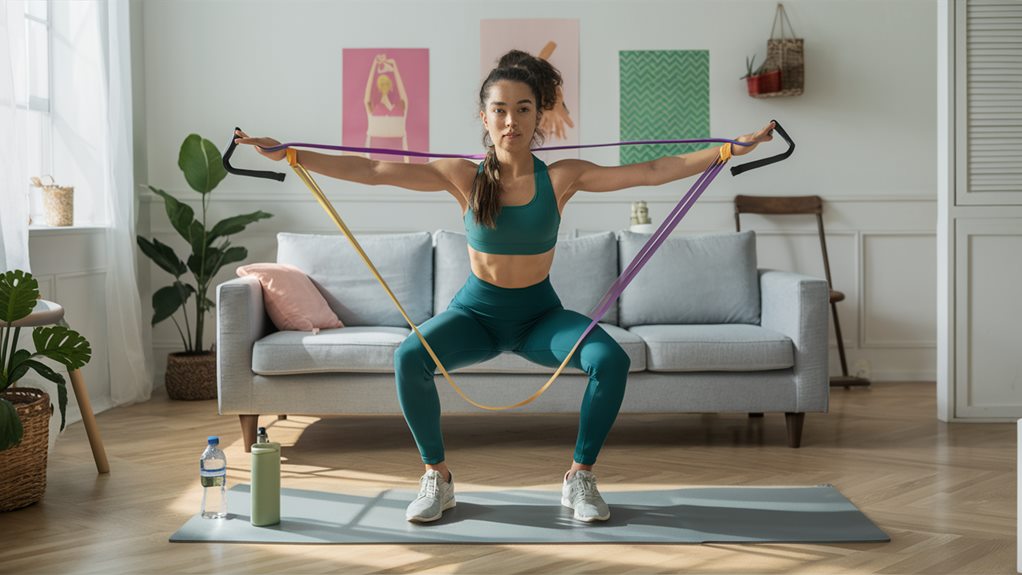
To maximize the benefits of resistance band workouts, it's important to keep a few key tips in mind. Whether you're a complete beginner or just getting back into the swing of things, following these guidelines will help you make the most of your sessions and feel part of a supportive fitness community.
- Focus on Proper Form: Always prioritize maintaining proper form during your exercises. This not only optimizes your results but also reduces the risk of injury. Engage your core, keep your movements controlled, and avoid using momentum. Remember, quality over quantity!
- Incorporate a Warm-Up: Before diving into your workout, spend a few minutes warming up your muscles. This could include dynamic stretches or light movements. Warming up gets your blood flowing and prepares your body for the resistance exercises ahead.
- Track Your Progress: Keeping a record of your workouts is essential for staying motivated. Write down the exercises you do, the resistance levels you use, and any improvements you notice. Not only will this help you see how far you've come, but it'll also guide you in adjusting your routine as you build strength.
Common Mistakes to Avoid
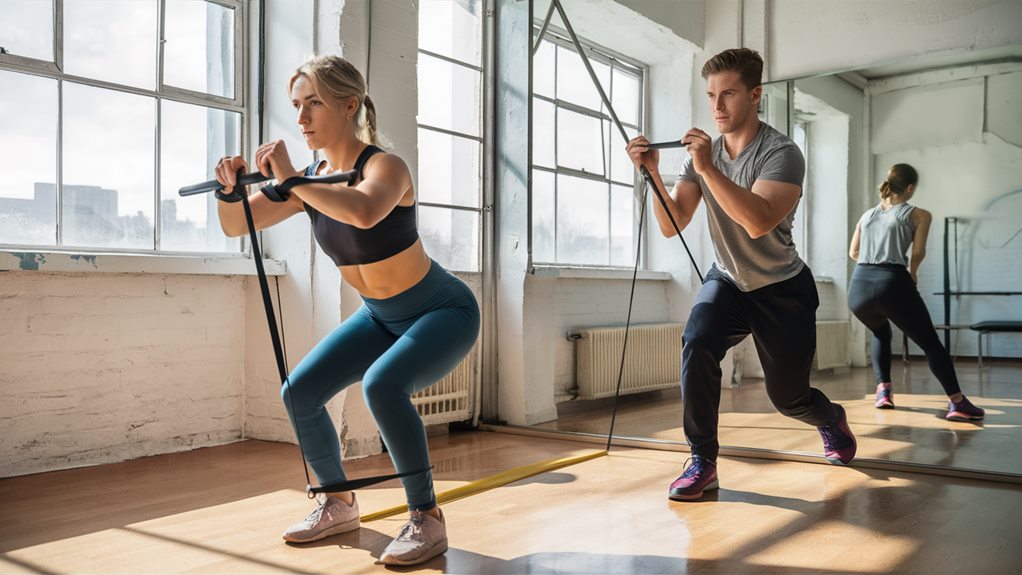
Avoiding common errors during resistance band workouts can significantly enhance your results and prevent injuries. One of the biggest challenges beginners encounter is overlooking proper form. You might be tempted to rush through your exercises, but focusing on your technique is vital. Make sure your movements are controlled and deliberate. Poor form can lead to strain or injury, and it's not worth jeopardizing your progress.
Another frequent mistake is selecting the wrong equipment. Resistance bands come in various strengths, and picking one that's too light or too heavy can impede your workout. If you can easily perform an exercise for more than 15 repetitions without breaking a sweat, the band might be too light. Conversely, if you struggle to complete even a few reps with good form, it's likely too heavy. Invest in a set of bands with varying resistance levels to guarantee you're challenged without risking injury.
Additionally, don't forget to warm up before starting your routine. A quick five-minute warm-up can prepare your muscles and joints for the workout ahead.
Lastly, pay attention to your body. If you feel pain (not to be confused with the normal burn of a workout), stop and reassess your form or the resistance level you're using. By being mindful of these common pitfalls, you'll set yourself up for success and create a supportive environment for your fitness journey. Remember, you're not alone—everyone makes mistakes, and learning from them is part of the process!
Frequently Asked Questions
How Often Should I Perform Resistance Band Workouts Each Week?
To maximize your results, aim for resistance band workouts two to three times a week. This progression frequency allows your muscles to adapt and grow while ensuring adequate muscle recovery.
Listen to your body; if you're feeling fatigued, don't hesitate to take an extra rest day. Consistency is key, but balance is essential.
You'll find that incorporating this routine into your week will help you feel stronger and more connected to your fitness journey.
Can Beginners Use Resistance Bands for Rehabilitation Purposes?
Absolutely, you can use resistance bands for rehabilitation, and they're a game-changer! Imagine feeling stronger and more flexible with every stretch. You'll reap amazing rehabilitation benefits if you use proper techniques.
These bands help you regain mobility and build strength without overwhelming your body. You'll feel like a superhero in no time! Just remember to start slow, listen to your body, and you'll be on your way to recovery and empowerment.
Are Resistance Bands Safe for Older Adults?
Yes, resistance bands are generally safe for older adults when used correctly. They offer numerous benefits, like improved strength and flexibility, while promoting injury prevention through low-impact exercises. However, it's important to make modifications based on individual fitness levels. Be aware of limitations, and always listen to your body. Starting with lighter bands can help you build confidence and guarantee a safe, effective workout that enhances your overall well-being.
What Should I Do if a Band Breaks During a Workout?
If a band breaks during your workout, don't panic—think of it like a flat tire on a road trip.
First, practice band maintenance regularly to prevent such mishaps. Always follow safety precautions.
If it snaps, you can improvise with emergency replacements or switch to alternative exercises. This way, you keep your routine going and stay safe.
Can I Combine Resistance Band Workouts With Other Forms of Exercise?
Absolutely, you can combine resistance band workouts with other forms of exercise! Incorporating yoga or Pilates can enhance flexibility and core strength, while mixing in cardio or strength training boosts your overall fitness. You'll find that resistance bands add variety and challenge to your routine, making it more engaging.
Plus, blending these exercises lets you target different muscle groups, keeping your workouts fresh and fun. Go ahead and explore these combinations for a well-rounded routine!
Conclusion
Incorporating resistance bands into your fitness routine can be a game changer for your strength and flexibility. With a variety of exercises at your fingertips, you'll feel like a sculptor chiseling away at your body's potential. Remember, consistency is key, and avoiding common pitfalls will help you progress. So grab your bands, stay motivated, and watch as you transform not just your physique, but your overall health. Your journey starts now—let's get moving!

